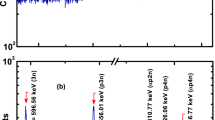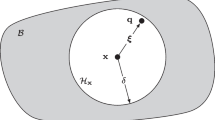Abstract
This work presents algorithm and methods for numerical calculation of multidimensional collision integrals based on the Monte Carlo method. The source code was used for the calculation of the pion damping width in hot nuclear matter taking all possible pion-pion scattering modes into account. For optimization of the computation the parallel calculation algorithm is implemented in C++ programming language using OpenMP and NVIDIA CUDA technology. Calculations are performed on nodes with multicore CPUs and Intel Xeon Phi coprocessors and Nvidia Tesla K40 accelerator installed within heterogeneous cluster of the Laboratory of Information Technologies, Joint Institute for Nuclear Research, Dubna.







Similar content being viewed by others
REFERENCES
I. Sobol, Numerical Monte-Carlo Methods (Nauka, Moscow, 1973) [in Russian].
S. P. Klevansky, “The Nambu–Jona-Lasinio model of quantum chromodynamics,” Rev. Mod. Phys. 64, 649 (1992). https://link.aps.org/doi/10.1103/RevModPhys.64.649.
Y. L. Kalinovsky and A. V. Friesen, “Properties of mesons and critical points in the Nambu–Jona-Lasinio model with different regularizations,” Phys. Part. Nucl. Lett. 12, 737 (2015).
L. P. Kadanoff and G. Baym, Quantum Statistical Mechanics (W. A. Benjamin, New York, 1962).
F. Wei-Jie and L. Yu-Xin, “Mesonic excitations and pi-pi scattering lengths at finite temperature in the two-flavor Polyakov–Nambu–Jona-Lasinio model,” Phys. Rev. D 79, 074011 (2009).
E. Quak, P. Zhuang, Y. L. Kalinovsky, S. P. Klevansky, and J. Hüfner, “π–π scattering lengths at finite temperature,” Phys. Lett. B 348, 1 (1995).
H. Bauke, Tina’s Random Number Generator Library, Version 4.24. https://www.numbercrunch.de/trng/ trng.pdf. Available March 27, 2021.
A. S. Antonov, Parallel Programming Technologies MPI and OpenMP, A Textbook (Mosk. Gos. Univ., Moscow, 2012) [in Russian].
NVIDIA CUDA C++ Programming Guide v11.5.0 (2021).
A. Wergieluk, D. Blaschke, Y. L. Kalinovsky, and A. Friesen, “Pion dissociation and Levinson’s theorem in hot PNJL quark matter,” Phys. Part. Nucl. Lett. 9, 660–668 (2012); arXiv: 1212.5245 [nucl-th].
A. V. Friesen, Yu. L. Kalinovsky, and V. D. Toneev, “Thermodynamics in NJL-like models,” hep-th/1102.1813 (2011).
P. Rehberg and S. P. Klevansky, “One loop integrals at finite temperature and density,” Ann. Phys. 252, 422–457 (1996).
A. S. Khvorostukhin, “Calculation of the one loop box integral at finite temperature and density,” arXiv: 2011.14596 [hep-ph] (2021).
S. R. Cotanch and P. Maris, “QCD based quark description of π–π scattering up to the σ and ρ regions,” Phys. Rev. D 66, 116010 (2002).
A. V. Friesen, Y. L. Kalinovsky, and V. D. Toneev, “Decay of a scalar σ-meson near the critical end-point in the PNJL model,” Phys. Part. Nucl. Lett. 9, 1 (2012); arXiv: 1104.2698 [nucl-th].
The GSL Team GNU Scientific Library v2.7. https://www.gnu.org/software/gsl/doc/html/montecarlo.html.
D. Blaschke, M. K. Volkov, and V. L. Yudichev, “Pion damping width from SU(2) X SU(2) NJL Model,” Phys. At. Nucl. 66, 1 (2003); arXiv: 0303034 [nucl-th].
The Laboratory of Information Technologies Heterogeneous Computing Cluster HybriLIT. http://hybrilit.jinr.ru.
Funding
The work was supported by the RFBR, grant no. 18-02-40137.
Author information
Authors and Affiliations
Corresponding authors
Ethics declarations
The authors declare that they have no conflicts of interest.
Rights and permissions
About this article
Cite this article
Friesen, A.V., Goderidze, D. & Kalinovsky, Y.L. Optimization of Monte Carlo Integration for Estimating of the Pion Damping Width. Phys. Part. Nuclei Lett. 19, 412–421 (2022). https://doi.org/10.1134/S1547477122040112
Received:
Revised:
Accepted:
Published:
Issue Date:
DOI: https://doi.org/10.1134/S1547477122040112




